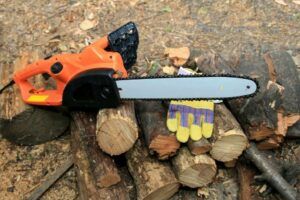
Chainsaw wood carving has grown into a very popular art form. Enthusiasts enjoy meeting to compete and show thousands of spectators how they can produce dynamically detailed carvings.
Many artists have had their works commissioned by museums, parks, malls, business interests or even to hold a place of prominence in someone’s backyard.
When wood carving typically suggests delicately detailed work using tiny hand tools, it makes the idea of carving with a chainsaw seem brutish and exaggerated, until you see it done.
If your interest has been stirred, I’ve got 10 helpful tips and tricks for beginners who are interested in chainsaw wood carving
Approach Your Efforts With Time And Love
Chainsaw wood carving is very gratifying and well worth the time you should take to learn both from this guide and from practicing to perfect your skills. This is not an art form that entertains shortcuts very well.
You need to set yourself up properly and take the time to do things right. Put the love of detail into setting up and carrying through, and it will produce results that you will love even more when you remain intact and unharmed.
My initial advice is as follows:
- Have patience
- Learn about your tools
- Start small
- Plan to upgrade to numerous chainsaws
- Practice
- Attend local carving events
- Find a mentor
- Ask lots of questions
If you have used a chainsaw as a utility tool, you undoubtedly have considered the clever ways these tools can be used to do more than harvesting, pruning or cleaning up.
Newbies to the craft of carving wood with the chainsaw as may even have used saws a bit larger than what you would want to use to create articulate designs.

Here are 10 tips and tricks for the beginner planning to use chainsaws to get started as a power wood carver.
1. Ensure Your Saws Are Sharp
Even with a manual saw, you notice the difficulty you have getting through the nature of wood grain when the tool is dull. Maintaining sharp tools not only makes the work easier, but you also take less of a risk of personal injury.
I know even with my accomplished skills, I can do some damage when I take a tool beyond its efficiency. I can even wreck my work. You can make tools sharp or take them to your local saw shop.
2. Have A Variety Of Chainsaws You Can Be Comfortable With Using On A Single Project
Whether you are working from an elaborate design or a rough outline, you will begin each project by cutting away the large chunks.
These are typically the first cuts made and should be performed using a larger tool. This may mean you get to deal with a very loud machine. That’s okay. Take some time to get accustomed to how loud it can be.
Fundamentally, you want to be at ease with your tools. As your project gets more defined, you will step down to smaller tools for more detail.
In some cases, you get all the way down to a grinder and dremel tool to articulate the finer details. Be comfortable at each stage and void working under stress.
Control the power with your dominant hand and ensure you are in a good position when carving. You do not want to be accommodating a cut with an awkward footing or stance.
3. Wear Proper Personal Protective Gear
You should always wear the proper safety gear anytime you operate a chainsaw. Starting with the obvious, have safety goggles, ear protection for the loud noise, woodworker’s gloves, a helmet, and steel-toed boots.
Remember, you are not working with a fixed tool that is fitted with safeguards. In essence, you are part of the mechanism in the perfect position to get hit with pieces that fly or kickback.
This is why I also recommend you wear chainsaw chaps to protect your legs as well.
Footnote: Our hearing is precious and irreplaceable. Whenever you are around noise, keep in mind that if you cannot have a conversation where you can hear each other speaking, the noise is doing some damage to your hearing.
When loud noise is prolonged, as in the example of spending time using your chainsaws to carve wood, you must wear protection for your ears. We lose our hearing gradually even though the damage is done years before that from the exposure to noise.
4. Get To Know Supply Of Working Materials: Timber!
At the main level of distinction, you only have two types of wood to work with: softwood or hardwood. I find useful aspects to both while appreciating the different behavior of each. Your design will have bearing upon which type of wood you select to use.
At the same time, the density of the wood does not necessarily dictate which type you use for a design, since you can gain mastery of the tools you use to get the results you are after.
With time and practice, you will discover the types of wood you prefer to work with and how the inherent qualities can help you produce a desired effect.
See also: The best woods for carving
5. Creating Your Designs
Chainsaw carving is very much like other methods of cutting away the material you need to discard to get down to the proper form and shape of your piece.
To quote Michelangelo, “The sculpture is already complete within the marble block, before I start my work. It is already there, I just have to chisel away the superfluous material.”
Similarly, with woodcarving, you are looking at what parts you need to cut away.
You could rough out a sketch and even transfer some initial cuts to the log you are working on. Your concerns will include:
- Proportion
- Cuts
- Carving shapes
- Marking cuts to make on the timber with a permanent marker
- Using the tip of the chainsaw to rough out the design on the outermost surface of the wood
As you progress, you will come up with an approach that serves you best. Keep in mind your first cuts are rough. The closer you get to the defined shape, the more detailed your cuts become.
As with all art forms, it is a process of degrees. This serves to help you keep all your limbs and digits, too.
6. Choosing The Right Chainsaws
As you may or may not be aware, chainsaws come in both gas-powered and electrical models. It is likely you will find most carvers prefer to use gasoline-powered chainsaws.
You can guess that has everything to do with avoiding the risk of cutting right through an electrical cord when the attention is focused on the art piece.
The best tool for you is the one you find the most comfort and confidence in working with. A tool that is too small will make your work tedious. Too big, and you could have trouble managing it. There is a lot of information available online, in stores and by simply researching to learn about chainsaws.
Ease of handling is as important for safety as it is for effectiveness. Your attention is spent on the work and less on the saw itself, even though a big part of your practice is in developing the skill of adapting to the physicality of movement when using it to cut into a log.
7. Helpful Information Regarding Chainsaws
At every step and phase of your use of chainsaws, consult the user’s manual. I say this because there is important information pertinent to your equipment that you need to be familiar with.
Aside from the motor and many other parts, you will be aware of the two that mean the most in your work: The bar and chain.
The chain must properly fit the bar to prevent a dangerous hazard. Correct tension on the chain will prevent kickback. A triangular bar will also allow you to be more precise with awkward cuts.
Like a pointed pencil, you can be more detailed. A sharp chain will also keep you from developing bad habits.
8. Support Your Work
Before you get into the big tree stumps, start with smaller stock not much larger than about 15-inches in diameter. You will need to functionally support the piece.
Sandbags are useful to keep your stock in place since you cannot have another person hold the piece for obvious reasons. As well, you need both hands to handle the power tool.
You can also use some plywood to create a base for your work. A log has a flat bottom that can be nailed to the plywood for stability.
Here is a helpful video that shows how to secure a log as well as covering a lot of what we have already covered.
As your skills advance, so too can your choice of materials. You will naturally want to graduate to larger pieces and maybe even choose to carve that stump in the yard versus having it removed.
9. Consult books Or Websites For More Ideas
If you can create your own designs, you are lucky. Many chainsaw woodcarvers consult others for ideas and patterns. You can purchase carving plans or even sell your own.
You also have the local craft stores and the library as sources for more ideas.
10. Finish Your Work For Protection
It is wise to finish your work with a sealer or a lacquer to preserve it. The elements still affect wood even after you have created a masterpiece.
In addition, you can choose to paint your pieces or stain them, perhaps even add other elements to them for visual appeal.
My best advice for the beginner getting started with chainsaw wood carving is to heed the safety precautions first above all other aspects of learning.
If you can develop this level of respect for the tools, you will enjoy what could very well become a career. Many wood carvers sell their works and make a living from it.
As you take some time to explore the level of craftsmanship that is achievable with this form of wood carving, you may become inspired to immerse yourself in the art.
It is a very sustainable medium as well since there are plenty of felled trees that present workable materials for your next project.

![How To Start A Woodworking Business [Ultimate Guide] How To Start A Woodworking Business [Ultimate Guide]](https://handykeen.b-cdn.net/wp-content/uploads/2021/10/woodworking-business-1-300x200.jpg)



![9 Best Pole Saws of 2023 [Ultimate Guide] 9 Best Pole Saws of 2023 [Ultimate Guide]](https://handykeen.b-cdn.net/wp-content/uploads/2021/03/best-pole-saw-300x200.jpg)

